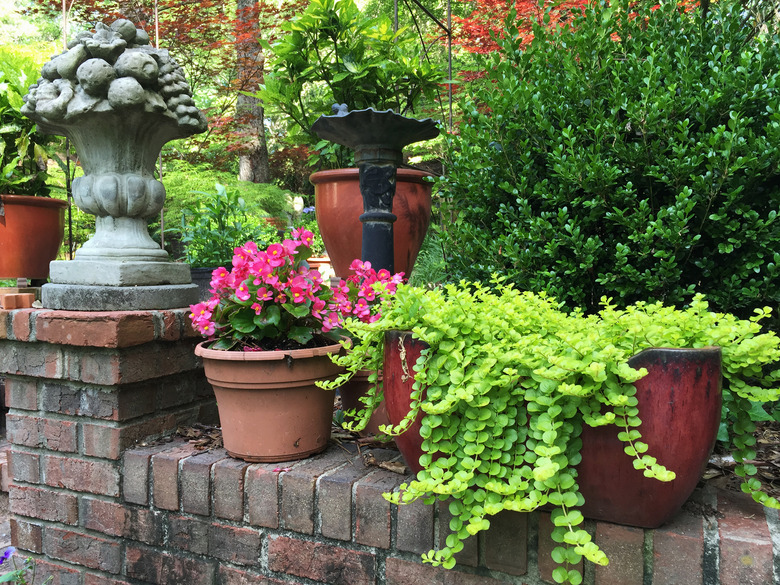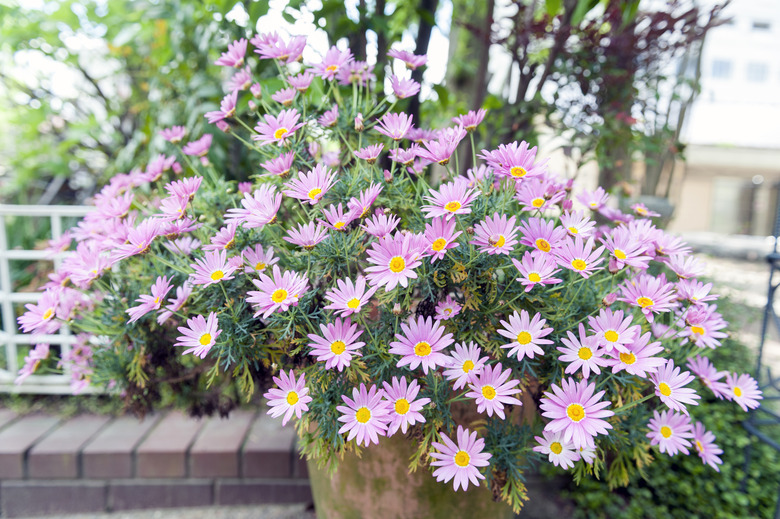The 10 Best Perennial Plants For Container Gardens
We may receive a commission on purchases made from links.
Container gardens are quite beautiful, and when they are planned well, they can prove to be easy to care for. Many gardeners view container gardening as too much work — because depending on the plants you choose, you'll have to lug heavy containers inside or bury them for the winter so your plants survive. However, if you choose the right perennials, your potted plants can easily survive the winter outside and may even add some winter color and visual interest. Here are the 10 best perennial plants for container gardens.
1. Green Mountain Boxwood
1. Green Mountain Boxwood
Green Mountain boxwood (Buxus 'Green Mountain') is a shallow-rooted evergreen that works well in containers. Hardy in USDA zones 5 through 8, Green Mountain usually grows to about 5 feet tall but will stay more petite in a container. The plant keeps its emerald-green foliage color all year and naturally develops into a pleasing pyramid shape that works well in containers.
This particular boxwood cultivar likes full sun or part shade. It will tolerate heavier shade if it must but will grow less vigorously and may lose density. Turn your boxwood periodically so that it doesn't grow crooked or produce bare spots. Water as needed to keep the soil evenly moist but not soggy; skip the water in the winter if the pot freezes since frozen soil won't absorb the water.
Note that boxwood shrubs can dry out in winter wind. To prevent this, consider applying an anti-desiccant. If necessary, you can prune your boxwood to remove dead wood and help maintain its shape. Prune in the spring after the danger of frost has passed so that new growth isn't damaged by freezing temperatures.
In winter, boxwoods are also susceptible to a condition called "boxwood bronzing," which turns the leaves a rusty brown to bronze color, because of drought, wind, or exposed sunny locations. If your boxwood experiences bronzing, it'll likely green up again in springtime.
2. Shade-Loving Bergenia
2. Shade-Loving Bergenia
Available to a large number of gardeners, bergenia (Bergenia cordifolia) is a perennial in zones 3 through 8. Also called pigsqueak, this plant features large, glossy leaves that are attractive in the summer and turn a coppery color in the fall. In the spring, bergenia produces 14- to 18-inch-tall stalks adorned with pink flowers that work well as cut flowers.
In warmer zones, bergenia can stay evergreen during the winter. In colder climates, winter weather can damage the leaves, but the plant will still survive the winter in its pot. Simply remove the damaged leaves as needed in the spring.
Bergenia likes partial to full shade and is perfect for a shady corner of the garden. It also likes damp but not soggy soil that drains well. It is somewhat drought tolerant but is less so in containers than in the ground.
3. Creeping Jenny Ground Cover
3. Creeping Jenny Ground Cover
Short but sweet, creeping Jenny (Lysimachia nummularia) only gets about 4 inches high, but its long stems may grow to 2 feet, either trailing down the sides of containers or creeping along the ground. This little plant makes a big impact in any shady or dog-friendly garden. Traditionally grown as a ground cover, the lime-green foliage on this plant looks beautiful spilling over the edge of a container. It also produces yellow flowers in early summer.
Creeping Jenny is a perennial in zones 3 through 8. The foliage will die back in the winter but overwinters well in a pot. Creeping Jenny is easy to care for, but it does like lots of water; it doesn't like to sit in puddles, but it will also suffer if the soil is allowed to dry out between waterings. When grown in a container, check the soil moisture every day until you get a feel for how much water the plant needs during the growing season.
4. Cheery Threadleaf Coreopsis
4. Cheery Threadleaf Coreopsis
Hardy in zones 3 through 9, threadleaf coreopsis (Coreopsis verticillata), also called tickseed, makes an excellent container plant. This cheery perennial produces flowers in yellow, pink, red or white all summer long. It also self-seeds prolifically, which means it's constantly dropping new seeds into the pot and refreshing itself. Deadhead to encourage more flowers or leave the seed heads on the plants for the birds in winter.
Like most plants, coreopsis likes moist soil, but it's more tolerant of dry soil than many other plants. This makes it a good choice for gardeners who forget to water their containers upon occasion. Just a little water and full sun are all coreopsis needs to bloom beautifully and attract butterflies.
5. Drought-Tolerant Salvia
5. Drought-Tolerant Salvia
Standing between 18 inches and 5 feet tall depending on the species and cultivar, salvia (Salvia spp.), commonly known as sage, grows well in containers. In perennial containers, however, it's important to make sure you get a perennial salvia and not one that is grown as an annual. Perennial salvias are hardy in zones 3 through 10, depending on species and cultivar, and come in a wide variety of colors including white, purple, blue, pink, red and yellow.
Salvia is easy to care for. It likes full sun and about an inch of water per week. It may need a bit more water when growing in a container so check it often, but like coreopsis, salvia will tolerate a little dryness if you forget to water it once in a while. Although not required, deadheading salvia will encourage extra blossoms.
6. Succulent Sedum Plants
6. Succulent Sedum Plants
Tolerant of drier soils, sedum (Sedum and Hylotelephium spp.), also known as stonecrop, is an excellent plant for containers. Although many species do flower, sedum is grown primarily for its vibrant foliage that comes in a wide variety of shapes and colors, from green to burgundy to gray. Sedum can be anywhere from a few inches to 3 feet tall and makes an excellent ground cover in sunny spots anywhere within USDA hardiness zones 3 through 11, depending on genus, species, and cultivar.
When growing in containers, gardeners often mix different colors and shapes in the same pot for an interesting and eye-catching display. You can also plant low-growing sedums in a pot and let them fill in around taller plants. Sedum needs six to eight hours of direct sunlight a day but very little water; you'll likely only need to water container plants once a week in the heat of summer. Your sedum will overwinter well in its pot, and if you leave the spent flowers on the plant, it can also provide seeds to feed the birds in the winter.
7. Stunning Alstroemeria aka Peruvian Lily
7. Stunning Alstroemeria aka Peruvian Lily
Sometimes called Peruvian lily, alstroemeria (Alstroemeria aurea) is an absolutely stunning plant that you should add to your container garden if you can. It admittedly has a limited growing range, but it's too gorgeous to ignore if you happen to live in the right climate. Alstroemeria is winter hardy in USDA zones 7 or 8 through 10, which means perennial container gardeners can only grow it in zones 9 or 10 through 12.
If you're fortunate enough to live where it grows, you'll enjoy the tropical feel that alstroemeria's early summer blossoms provide. These flowers bloom in yellows, pinks and oranges and feature dark stripes that add to their beauty. These plants reach heights up to 3 feet and work well alone or as a centerpiece for a large container with other plants. They also work well as cut flowers, lasting about two weeks in a vase, and since they have no fragrance, you can use them as a centerpiece on your dining table.
Alstroemeria likes moist soil and direct sunlight, which is a combination that may require a lot of water. Check your containers often, as daily watering isn't out of the question. Water only minimally in the winter, however. You may need to stake your alstroemeria in the summer to help keep top-heavy plants upright.
8. The Daisy-Like Asters
8. The Daisy-Like Asters
If your container garden looks great in the summer but starts to lose some of its luster in the fall, consider adding asters (Symphyotrichum spp.). Closely resembling daisies, asters bloom from late summer into fall and can provide rich hues of blue, purple or white flowers when other blooming plants are starting to fade.
Asters do well in USDA zones 3 through 10, depending on species and cultivar, and often attract butterflies. They reach heights of 8 to 36 inches depending on the variety. Some of the taller varieties can require staking. Otherwise, they only need full or partial sun and about an inch of water a week.
Like coreopsis, asters readily self-seed. The seeds don't always stay true to the parent plant, however. This means that a white aster could pop up in a pot of purple flowers. You can remove the intruder if it ruins your aesthetic, but many gardeners simply view this type of occurrence as a fun surprise.
9. Golden Sword Yucca
9. Golden Sword Yucca
The Golden Sword yucca (Yucca filamentosa 'Golden Sword') leans toward drier soils and is an excellent choice for perennial containers. Like all container-grown plants, the yucca will need more water in a pot than it will in the ground but may prove forgiving of occasional watering oversights.
This evergreen plant produces yellow and green variegated, spearlike leaves all year in zones 4 through 9. This foliage reaches 3 feet in height. In the spring, long ivory flower spikes raise the plant's height to about 6 feet. These flowers are striking and fragrant but will lack their usual luster if the plant doesn't receive the full sun it craves.
10. Showy Coral Bells
10. Showy Coral Bells
Because they like soil that drains well, coral bells (Heuchera spp.) grow well in perennial container gardens. Their heart-shaped leaves come in a wide array of colors, from pale green to deep purple, and many feature attractive veining and ruffled edges. The evergreen foliage stuns all year, but coral bells also produce showy flowers from late spring into the summer. Deadheading will encourage more blossoms.
The plants grow 12 to 24 inches high depending on the cultivar, and grow as perennials in zones 3 through 9. Some cultivars like full sun, but others will scorch in direct sunlight and need partial shade. It's also important that you don't confuse their preference for well-draining soil with drought tolerance. They like their soil to drain well so it doesn't get soggy, but they'll be happiest if you keep it evenly moist.

